- Instrument is 100% original: finish, bridge, ivory nut, ivory saddle, ivory bridge pins, bar frets
- Brazilian Rosewood Back and Sides
- Adirondack Spruce top
- Shows very little wear
- Scalloped braces (X-braced)
- Original maple bridge plate in perfect condition
- Original French-polish shellac finish throughout
- 13.5" wide at lower bout, and 4.25" deep at the endpin
- 24.9" scale length
- 1-7/8" wide nut
- Soft-V neck profile
- A couple small top cracks, professionally repaired and not an issue. Two finish checks/cracks, that due not go through wood, on back
-
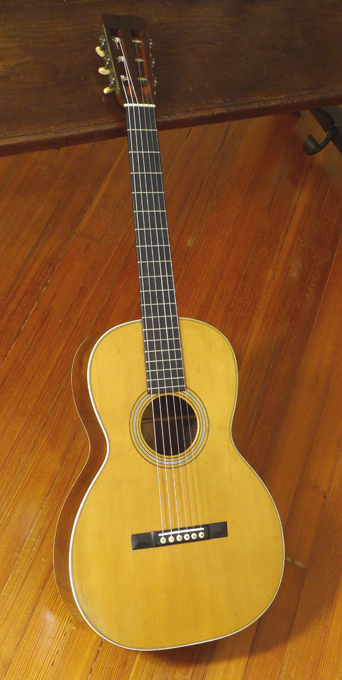 Signed by Martin factory foreman, underside of top: “Dec. 8, 1893”, this 0-28 is in wonderful original condition.
Signed by Martin factory foreman, underside of top: “Dec. 8, 1893”, this 0-28 is in wonderful original condition. -
 This extraordinary guitar, completed by C.T. Beitel in June of 1894, is signed and dated by him on the underside of the top. The guitar is in remarkably original condition. And it plays wonderfully. C.T. Beitel (Clemence T. Beitel, 1869-1916) was closely associated with C.F. Martin & Co. in the 1890’s. The Beitels are well known to have been closely associated with the Martin family in these years, both personally (including through marriage) and in the Martin guitar business. According to some correspondence and background research from family members obtained with this guitar, C.T. Beitel was the first American-born person to serve an apprenticeship at Martin Guitars. C.T. Beitel was a cousin to C.A. Zoebisch– who was of course the famous Martin guitar distributor and sometimes-partner of C.F. Martin & Co. in this period. Although this guitar is strikingly faithful to Martin specs, this is most likely one of C.T. Beitel’s guitars made by him to market separately from Martin. It is documented that at least one of the Beitel family had an ongoing guitar making and marketing business in the late 1890’s. Is this Beitel guitar one of the first made under the “Beitel” name? Certainly. Are there others remaining today? There are none known of by us–making this a rare and highly collectible guitar. Similar to a Martin 2-27… but not exactly. More like a cross between a 2-27, a “28” style–because of the wonderful Herringbone purfling/binding on the top– and a 30’s or higher style with its very fancy Jerome tuners.
This extraordinary guitar, completed by C.T. Beitel in June of 1894, is signed and dated by him on the underside of the top. The guitar is in remarkably original condition. And it plays wonderfully. C.T. Beitel (Clemence T. Beitel, 1869-1916) was closely associated with C.F. Martin & Co. in the 1890’s. The Beitels are well known to have been closely associated with the Martin family in these years, both personally (including through marriage) and in the Martin guitar business. According to some correspondence and background research from family members obtained with this guitar, C.T. Beitel was the first American-born person to serve an apprenticeship at Martin Guitars. C.T. Beitel was a cousin to C.A. Zoebisch– who was of course the famous Martin guitar distributor and sometimes-partner of C.F. Martin & Co. in this period. Although this guitar is strikingly faithful to Martin specs, this is most likely one of C.T. Beitel’s guitars made by him to market separately from Martin. It is documented that at least one of the Beitel family had an ongoing guitar making and marketing business in the late 1890’s. Is this Beitel guitar one of the first made under the “Beitel” name? Certainly. Are there others remaining today? There are none known of by us–making this a rare and highly collectible guitar. Similar to a Martin 2-27… but not exactly. More like a cross between a 2-27, a “28” style–because of the wonderful Herringbone purfling/binding on the top– and a 30’s or higher style with its very fancy Jerome tuners.- No “Martin” stamps anywhere
- “C.T. Beitel” paper label on neck block (Martin stamp beneath the label? Uncertain)
- Signed and dated on underside of top: “C.T. Beitel, 6/94, Easton” (i.e. Easton, PA)
- X-braced top
- All original finish; no touch-ups etc
- Pearl inlay around sound hole
- Herringbone purfling around top
- Real Ivory binding, top, and back
- Bound Ivory neck
- Ebony bridge
- Ebony fretboard (bound in Ivory)
- Original Maple bridge plate
- Size: a just bit bigger at lower bout than a Martin “2” size: 12 1/4 inches
- Scale length: 24 3/4 inches
- Body length: 18 3/8 inches
- String spacing at bridge: 2 3/8 inches - Nut width: 1 7/8 inches
- Body depth at bottom of guitar: 4 inches
- Top: Adirondack Spruce
- Back and sides: solid Brazilian Rosewood
- Neck: Cedar
- Headstock: Brazilian Rosewood veneer
- Tuners: original, German-made Jerome tuners, with fancy flower engraving, and oval shaped Ivory tuner buttons. These tuners are typically found only on the highest model Martin guitars of those years
- Tuner buttons: Ivory, oval-shaped
-
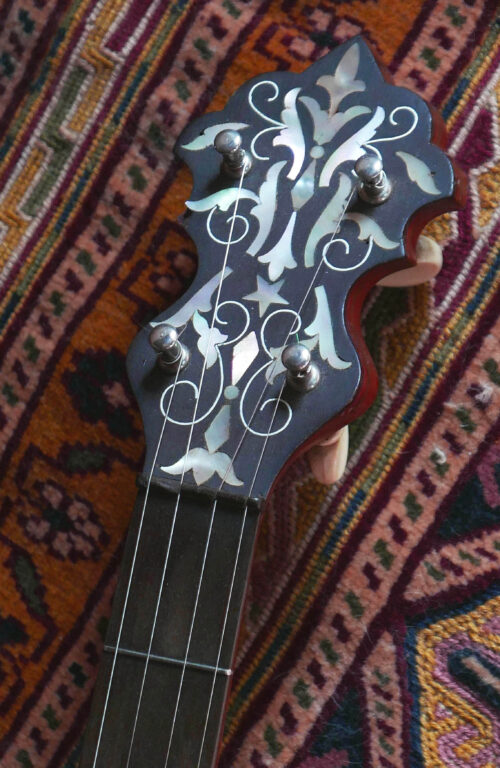 A rare, circa 1895 S.S. Stewart “Special Thoroughbred” 5-string banjo, in original condition. Silver plated pot 5-string neck is cherry Ebony fingerboard Carved heel Mother of pearl headstock inlays, with silver wire inserts also Tone ring is nickel plated on a birds-eye maple pot All of the special logos etc, are still on the inside of the banjo. Condition: amazing, original condition. Does have some wear, but it’s still shiny, and in great condition. (It even has its original leather case, not a very practical case, but original.) Tone is very nice, more focused and loud than the typical turn of the century open-back banjo. Price: $2950.
A rare, circa 1895 S.S. Stewart “Special Thoroughbred” 5-string banjo, in original condition. Silver plated pot 5-string neck is cherry Ebony fingerboard Carved heel Mother of pearl headstock inlays, with silver wire inserts also Tone ring is nickel plated on a birds-eye maple pot All of the special logos etc, are still on the inside of the banjo. Condition: amazing, original condition. Does have some wear, but it’s still shiny, and in great condition. (It even has its original leather case, not a very practical case, but original.) Tone is very nice, more focused and loud than the typical turn of the century open-back banjo. Price: $2950. -
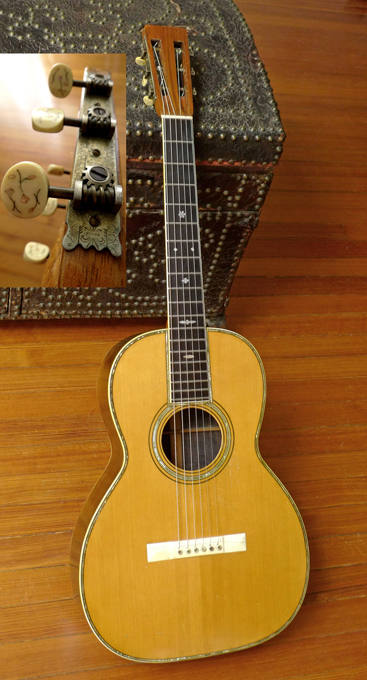 Exquisite, and a joy to play (… the top level, largest guitar that Martin made at the turn of the 20th century– with tone that shows off what Frank Henry Martin was proud of when he personally signed the inside of this instrument in April, 1903…)
Exquisite, and a joy to play (… the top level, largest guitar that Martin made at the turn of the 20th century– with tone that shows off what Frank Henry Martin was proud of when he personally signed the inside of this instrument in April, 1903…) -
 This fine Brazilian Rosewood 12-fret Martin is a joy to play, and it’s properly set up for steel strings. The grandson of C. F. Martin, Sr., Frank Henry Martin oversaw the Martin business from 1880 until well into twentieth century, and was responsible for the creation of the Style 0. I’m sure he loved this guitar–he personally signed the instrument, in cursive, under the top: “# 10082 Oct. 17th, 1905 F.H.M.” This 0-21 combines the exquisite tone of a 100 year old Martin, with some wonderful restoration. Guitar was refinished, probably decades ago, and it is a beautiful, French polish finish that has all the earmarks of an original finish. You can see the pores and saw marks in the Brazilian rosewood. No heavy-handed finish here, it’s a natural finish that lets the grain and color of the wood come through. And the tone, too, that sweet tone you can only get from Brazilian this old. The ebony pyramid bridge is a replacement, and features a compensated saddle, so intonation is dead on. (The bridge plate is the original small maple plate, in perfect condition.) Original tuners. Crack-free top and sides. There is only one very small crack, on the back, about 3 inches long, professionally repaired. The neck was set recently by Tony Nobles, and the original bar frets dressed. It plays, and sounds, like a late 20’s 12-fret Brazilian rosewood Martin.
This fine Brazilian Rosewood 12-fret Martin is a joy to play, and it’s properly set up for steel strings. The grandson of C. F. Martin, Sr., Frank Henry Martin oversaw the Martin business from 1880 until well into twentieth century, and was responsible for the creation of the Style 0. I’m sure he loved this guitar–he personally signed the instrument, in cursive, under the top: “# 10082 Oct. 17th, 1905 F.H.M.” This 0-21 combines the exquisite tone of a 100 year old Martin, with some wonderful restoration. Guitar was refinished, probably decades ago, and it is a beautiful, French polish finish that has all the earmarks of an original finish. You can see the pores and saw marks in the Brazilian rosewood. No heavy-handed finish here, it’s a natural finish that lets the grain and color of the wood come through. And the tone, too, that sweet tone you can only get from Brazilian this old. The ebony pyramid bridge is a replacement, and features a compensated saddle, so intonation is dead on. (The bridge plate is the original small maple plate, in perfect condition.) Original tuners. Crack-free top and sides. There is only one very small crack, on the back, about 3 inches long, professionally repaired. The neck was set recently by Tony Nobles, and the original bar frets dressed. It plays, and sounds, like a late 20’s 12-fret Brazilian rosewood Martin. -
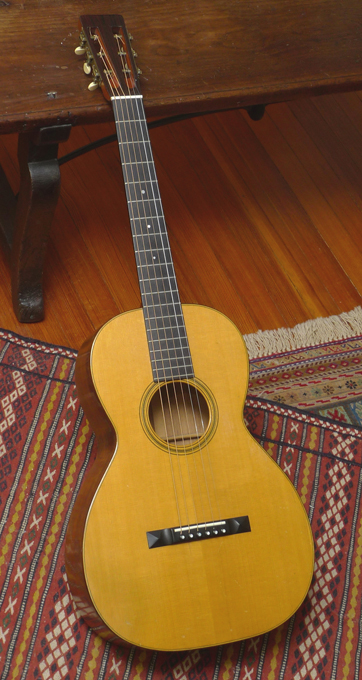 The grandson of Martin Guitar founder C. F. Martin, Sr., Frank Henry Martin suddenly found himself in control of the family business at the age of 22 when his father died in 1888 and left him unexpectedly in charge. The guitar market was still immature, and the young country was headed into an economic panic in the 1890's, but the young Frank Henry Martin quickly turned a traditional German business close to bankruptcy into a major force in the world of American music. Along with the young Frank Martin’s now legendary work ethic and marketing acumen, he is credited with personally revamping the Martin model line-up at the turn of the new century. Eschewing the trappings of an executive, he literally worked along side the shop craftsmen, day in and day out, six days a week. And he made the Style 18 the mainstay of the Martin catalog. This instrument is a living testament to that legacy– he personally signed this instrument, in cursive, under the top, on the fourth of February, 1907: “ 10381 2/4/07 F.H.M. ” Martin was still using Brazilian Rosewood for the back and sides for their 0-18 model in this 1907, and the tone of this instrument reflects all that is great about the combination of Brazilian back and sides, and Adirondack spruce (top), with a cedar neck, on the perennially great Size 0 Martin 12-fret, in all its Brazilian rosewood permutations through two centuries. This guitar is in remarkably original condition, and is completely crack-free. Just a few minor dings and superficial scratches. The finish is 100% original, with no touch-ups of any kind. The bar frets were replaced by us with period-correct bar frets–with material obtained from T.J. Thomson. (Several frets were missing, so we decided to replace all the frets.) Original ivory saddle, and bridge pins. Bridge has never been off the guitar. At some time in the past a neck set was done, so action is great, and the neck is straight. Original ebony nut is in the case. An ivory nut is installed on the guitar to accommodate silk & steel strings–which it does wonderfully. An Adirondack/Brazilian 12-fret 0-sized Martin over a century old yet in this kind of original condition, is very rare.
The grandson of Martin Guitar founder C. F. Martin, Sr., Frank Henry Martin suddenly found himself in control of the family business at the age of 22 when his father died in 1888 and left him unexpectedly in charge. The guitar market was still immature, and the young country was headed into an economic panic in the 1890's, but the young Frank Henry Martin quickly turned a traditional German business close to bankruptcy into a major force in the world of American music. Along with the young Frank Martin’s now legendary work ethic and marketing acumen, he is credited with personally revamping the Martin model line-up at the turn of the new century. Eschewing the trappings of an executive, he literally worked along side the shop craftsmen, day in and day out, six days a week. And he made the Style 18 the mainstay of the Martin catalog. This instrument is a living testament to that legacy– he personally signed this instrument, in cursive, under the top, on the fourth of February, 1907: “ 10381 2/4/07 F.H.M. ” Martin was still using Brazilian Rosewood for the back and sides for their 0-18 model in this 1907, and the tone of this instrument reflects all that is great about the combination of Brazilian back and sides, and Adirondack spruce (top), with a cedar neck, on the perennially great Size 0 Martin 12-fret, in all its Brazilian rosewood permutations through two centuries. This guitar is in remarkably original condition, and is completely crack-free. Just a few minor dings and superficial scratches. The finish is 100% original, with no touch-ups of any kind. The bar frets were replaced by us with period-correct bar frets–with material obtained from T.J. Thomson. (Several frets were missing, so we decided to replace all the frets.) Original ivory saddle, and bridge pins. Bridge has never been off the guitar. At some time in the past a neck set was done, so action is great, and the neck is straight. Original ebony nut is in the case. An ivory nut is installed on the guitar to accommodate silk & steel strings–which it does wonderfully. An Adirondack/Brazilian 12-fret 0-sized Martin over a century old yet in this kind of original condition, is very rare. -
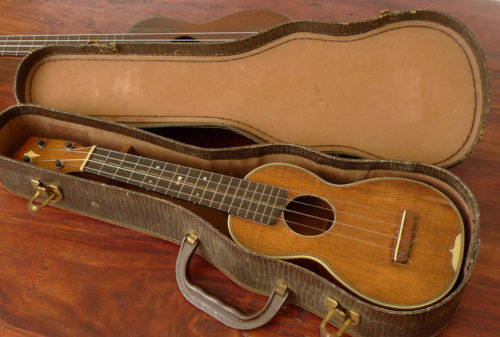 One of the first Martin 3K Ukeleles ever made. This is possibly a prototype, one of the first, all hand-made Martin 3K Ukeleles, made probably before the official introduction of the model by Martin in 1919-1920. It has many signs that it was the one of the first ones:
One of the first Martin 3K Ukeleles ever made. This is possibly a prototype, one of the first, all hand-made Martin 3K Ukeleles, made probably before the official introduction of the model by Martin in 1919-1920. It has many signs that it was the one of the first ones:- Ebony fretboard is hand-cut
- Fretboard inlays are hand-cut
- There is an "A" on the back of headstock... could be a marking by the Martin craftsmen in-house to indicate a prototype.
- Several cracks on back (repaired)
- Two cracks on top (repaired)
- There is one missing brace, a back brace, inside. Since ukeleles are so small, that brace has no real structural importance, so we decided not to replace it
- The sound hole was at some point enlarged slightly, either at the factory, or later. Probably later– so we’ll call it the Tony Rice model… this modification does add loudness
- The finish is all original.
- Original striped nut
- 3 lines inlaid down center of fingerboard.
- 7 ply side binding
- Celluloid ornament on top, behind bridge (known as the "parend").
- Small pearl paired-diamond inlays at fret 5, 7, 9– hand-cut. With the “bowtie” at the 7th fret
- Kite-shaped celluloid ornament on front of headstock
- Original friction pegs
- Ebony fretboard
- C.F. Martin & Co. stamp on back of headstock.
-
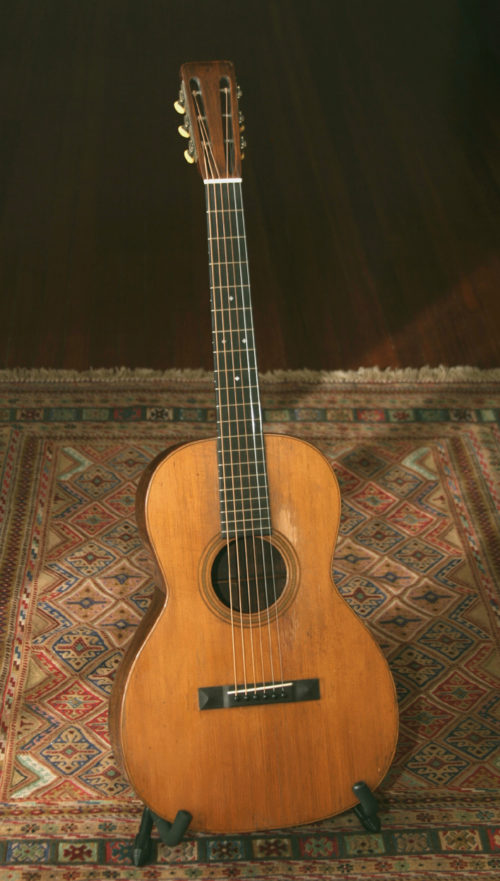 This big 12-fret Brazilian Rosewood pre-war Martin is properly set up for steel strings, with new replacement ebony pyramid bridge meticulously made to original specs, but compensated for steel string, perfect intonation. All braces original and in great shape. Original bridge plate. All original finish everywhere. This guitar has all the tone you'd expect from a pre-war 00 Brazilian Martin. It's had restoration work, all by us, recently, as follows. Hide glue used in all repairs/restoration.
This big 12-fret Brazilian Rosewood pre-war Martin is properly set up for steel strings, with new replacement ebony pyramid bridge meticulously made to original specs, but compensated for steel string, perfect intonation. All braces original and in great shape. Original bridge plate. All original finish everywhere. This guitar has all the tone you'd expect from a pre-war 00 Brazilian Martin. It's had restoration work, all by us, recently, as follows. Hide glue used in all repairs/restoration.- Several cracks in sides, back, and top professionally repaired (5 or 6 cracks overall)
- Small hole drilled in top of headstock many decades ago (to hang the guitar on a wall presumably) has been expertly filled and finished with a piece of Brazilian rosewood veneer, on front, to match the veneer of the headstock.
- Neck set.
- New replacement ebony pyramid bridge meticulously made to original specs, but compensated to steel string intonation. Scratch marks in spruce top, on either side of bridge, filled and finished.
- All new, replacement Bar Frets
- To the thin maple, original bridge plate, we carefully added tiny maple ring/plugs, with hide glue, into the holes, to address bridge pins holes slightly enlarged over the years.
- Older repaired small crack in heel expertly touched up. It's 100% stable. (It appears to be a surface/finish crack.) It's very hard to see even up close, and impossible to photograph.
-
Out of stock
 The Larson Brothers of Chicago never marketed any guitar, throughout their long career, that was marked “Larson”. Their designs were branded by Maurer, Stahl, Prairie State, Stetson, and a few other guitar makers– but never “Larson”. They were also known for making many “off-catalog” guitars, i.e. guitars with combinations of features that varied from the Maurer, Stahl, etc, catalogs, and guitars that were not marked at all with a brand. This guitar is a Larson Bros creation that is not marked at all. It is a custom made instrument–but it has all the typical Larson hallmarks. The tone of this Larson is every bit as wonderful as the Maurer/Larson listed above, indeed it is quite similar, due to the same patented “built under tension” design, and X-bracing. This Larson does not have laminated braces (it’s well documented that laminated braces were only used on certain models–and their use was not related to level or price.) Every part of this guitar is original, including original finish. There are two repaired cracks on the back, and three small, repaired cracks on top.
The Larson Brothers of Chicago never marketed any guitar, throughout their long career, that was marked “Larson”. Their designs were branded by Maurer, Stahl, Prairie State, Stetson, and a few other guitar makers– but never “Larson”. They were also known for making many “off-catalog” guitars, i.e. guitars with combinations of features that varied from the Maurer, Stahl, etc, catalogs, and guitars that were not marked at all with a brand. This guitar is a Larson Bros creation that is not marked at all. It is a custom made instrument–but it has all the typical Larson hallmarks. The tone of this Larson is every bit as wonderful as the Maurer/Larson listed above, indeed it is quite similar, due to the same patented “built under tension” design, and X-bracing. This Larson does not have laminated braces (it’s well documented that laminated braces were only used on certain models–and their use was not related to level or price.) Every part of this guitar is original, including original finish. There are two repaired cracks on the back, and three small, repaired cracks on top.- Lower bout width: 12 5/8 inches
- Brazilian rosewood back and sides
- Ivory celluloid Bound fretboard
- Ivory celluloid Bound headstock
- Spruce top
- X braced
- Larson’s patented “built under tension” design
- Rosette: Abalone pearl and wood inlay bordering the sound hole
- Radiused ebony fingerboard, and Classic Larson Brothers’ “ebony below the binding”
- Engraved inlays on fretboard
- Original tuners
- Original ebony bridge
- Original bridge pins
- 1-7/8" wide nut
- 2 1/4" bridge string spacing
- 24.3" scale length
- One-piece mahogany neck, round C shaped neck profile.
-
 The Larson Brothers of Chicago never marketed any guitar, throughout their long career, that was marked “Larson”. Their designs were branded by Maurer, Stahl, Prarie State, Stetson, and a few other guitar makers– but never “Larson”. They were also known for making many “off-catalog” guitars, i.e. guitars with combinations of features that varied from the Maurer, Stahl, etc, catalogs, and guitars that were not marked at all with a brand. This guitar is a Larson Bros creation that is not marked at all. It is a custom made instrument–but it has all the typical Larson hallmarks. The tone of this Larson is every bit as wonderful as the Maurer/Larson listed above, indeed it is quite similar, due to the same patented “built under tension” design, and X-bracing. This Larson does not have laminated braces (it’s well documented that laminated braces were only used on certain models–and their use was not related to level or price.) Every part of this guitar is original, including original finish. There are two repaired cracks on the back, and three small, repaired cracks on top.
The Larson Brothers of Chicago never marketed any guitar, throughout their long career, that was marked “Larson”. Their designs were branded by Maurer, Stahl, Prarie State, Stetson, and a few other guitar makers– but never “Larson”. They were also known for making many “off-catalog” guitars, i.e. guitars with combinations of features that varied from the Maurer, Stahl, etc, catalogs, and guitars that were not marked at all with a brand. This guitar is a Larson Bros creation that is not marked at all. It is a custom made instrument–but it has all the typical Larson hallmarks. The tone of this Larson is every bit as wonderful as the Maurer/Larson listed above, indeed it is quite similar, due to the same patented “built under tension” design, and X-bracing. This Larson does not have laminated braces (it’s well documented that laminated braces were only used on certain models–and their use was not related to level or price.) Every part of this guitar is original, including original finish. There are two repaired cracks on the back, and three small, repaired cracks on top.- Lower bout width: 12 5/8 inches
- Brazilian rosewood back and sides
- Ivory celluloid Bound fretboard
- Ivory celluloid Bound headstock
- Spruce top
- X braced
- Larson’s patented “built under tension” design
- Rosette: Abalone pearl and wood inlay bordering the sound hole
- Radiused ebony fingerboard, and Classic Larson Brothers’ “ebony below the binding”
- Engraved inlays on fretboard
- Original tuners
- Original ebony bridge
- Original bridge pins
- 1-7/8" wide nut
- 2 1/4" bridge string spacing
- 24.3" scale length
- One-piece mahogany neck, round C shaped neck profile.
-
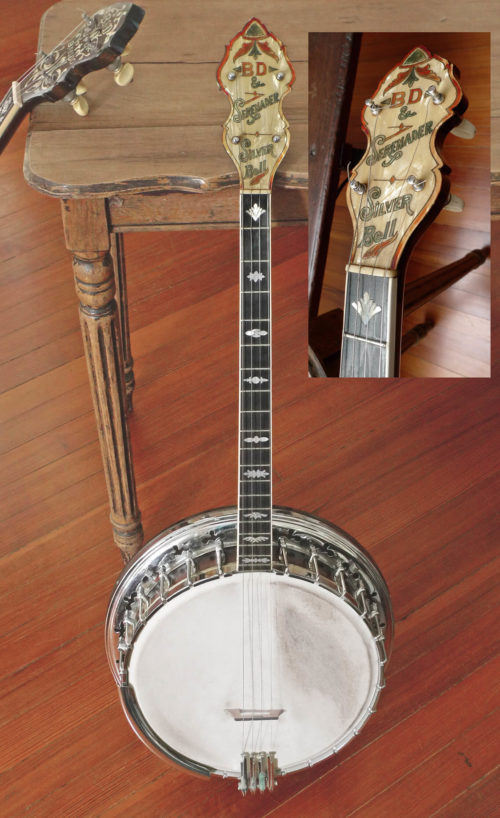 This 1922 Bacon & Day Serenader, tenor banjo is in great original condition. The well-worn head can be easily replaced– we retained it for originality. The banjo shows little wear. And all the parts are original–Tailpiece, tuners, dowel, everything. This is a golden era B&D, not one of the later 30s/40's banjos that are more common. In this condition it is rare. And it comes in its original hard shell case. Price: $1695.
This 1922 Bacon & Day Serenader, tenor banjo is in great original condition. The well-worn head can be easily replaced– we retained it for originality. The banjo shows little wear. And all the parts are original–Tailpiece, tuners, dowel, everything. This is a golden era B&D, not one of the later 30s/40's banjos that are more common. In this condition it is rare. And it comes in its original hard shell case. Price: $1695. -
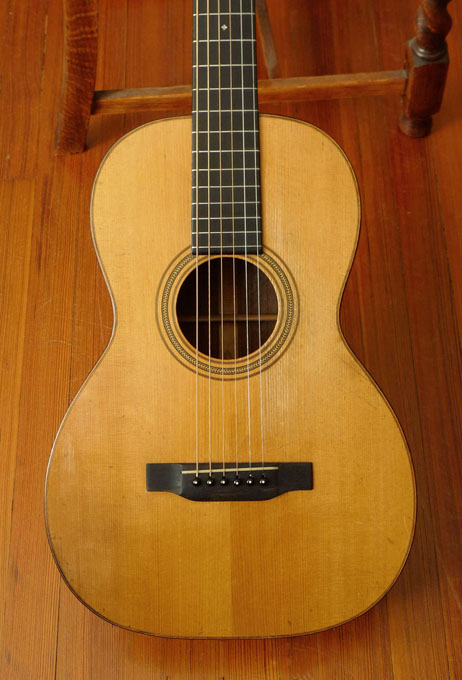 This is a wonderful Martin 0-21, but with “the best of both worlds”: the light build of 1924– combined with 1930’s robust, “braced for steel” construction. It left the factory in 1924, but it went back to Martin in 1934 for a neck set, new belly bridge, and to get set up fully for steel strings. Details below.
This is a wonderful Martin 0-21, but with “the best of both worlds”: the light build of 1924– combined with 1930’s robust, “braced for steel” construction. It left the factory in 1924, but it went back to Martin in 1934 for a neck set, new belly bridge, and to get set up fully for steel strings. Details below.- All original finish
- Original 1934 bridge, and bridge plate from Martin Factory
- Original saddle
- Original “arrowhead” design tuners. The first Waverly tuners showed up in 1924/25 and remained until after the war. The arrowhead design, seen here on the tuner plates, showed up also in 1924, still with the shafts placed underneath the gears / string posts.
- Crack free (there is one cleat inside guitar, on upper bout, back. There is no visible crack that goes through wood to inside, just a tiny finish crack on outside. No doubt the Martin luthier place the cleat there in 1934 as a preventative measure (that worked).
- The combination of the original thin-profile neck, with the braced-for-steel modifications by Martin factory in 1934, make for a very robust guitar– you can play it hard and it holds up and projects like a 30’s Martin.
- Sold by Martin factory and shipped to Rudolph Wurlitzer Co. in Chicago on March 18, 1924. (This guitar does not have “Wulitzer” stamps, rather the normal CF Martin Stamps in all the correct places. This is consistent with Martin/Wurlitzer timetable in “Martin Guitars: A Technical Reference” by Johnston and Boak, 2009, p. 248.)
- June 20, 1933: the owner wrote to Martin that instrument needed a neck set and the bridge was “adrift”. Martin replied on June 23 that the normal guarantee would probably cover this work.
- Owner sent the guitar to Martin on July 3, 1934. Martin reported back to owner on July 16 that readjusting the neck and regluing the bridge would be covered by the warranty, Martin also offered a “new” bridge (meaning belly bridge) for $1.50. Martin also said that some binding could be reglued and repaired for $3.00.
- Work done at Martin, July 1934. The luthier at Martin replaced the bridge with a 1934 spec ebony belly bridge, and replaced the bridge plate with a perfect, tucked, small maple bridge plate. Martin luthier signs underside of spruce top: "7-25-1934”, and put his initials (“W.T.W.”), right by the edge of the X-brace to the top/upper bout. Of course, the back was taken off the guitar to do the above work. But being perfectly done at Martin factory in 1934, there are no visible signs of that– back binding is perfect.
- Total repair bill from Martin factory in 1934: $4.50. Paid by check, and Martin return ships the 0-21 to owner on August 15th, 1934.